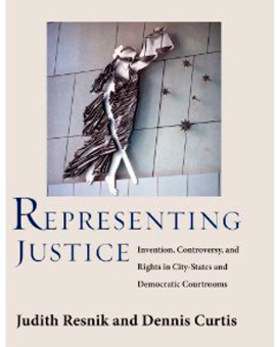Scholars examine ‘Lady Justice’ icon through ages, around world
Published 4:00 am Sunday, December 19, 2010

- Scholars examine 'Lady Justice' icon through ages, around world
“Representing Justice” by Judith Resnik and Dennis Curtis (Yale University Press, 720 pgs, $75)
In ancient Egypt she was known as Maat, the goddess of harmony and order, depicted in the Book of the Dead as a kind of personified jeweler’s scale, weighing a human heart against a feather to determine a soul’s fate in the afterlife.
In Greece she became Themis, sister, wife and counselor to Zeus, and the Romans then rolled her and her daughter Dike together to form Justitia, the only one of the cardinal virtues to have a signature look in ancient art. But the look of the grande dame we have come to know as Lady Justice — as interpreted by artists like Giotto, Bruegel and Reynolds — has been as changeable as a catwalk model’s.
She has strode forth naked and clothed, shoeless and shod, sword wielding and weaponless. She has been accompanied by a dog (for fidelity), a snake (for hatred) and a whole menagerie of other sidekicks.
Blind? Not always
As the Yale Law School professors Judith Resnik and Dennis Curtis show in an unusual new book just out, “Representing Justice” — an academic treatise on threats to the modern judiciary that doubles as an obsessive’s tour of Western art through the lens of the law — Lady Justice’s familiar blindfold did not become an accessory until well into the 17th century. And even then it was uncommon because of the profoundly negative connotations blindfolds carried for medieval and Renaissance audiences, who viewed them as emblems not of impartiality but of deception.
“Sight was the desired state,” Resnik and Curtis write, “connected to insight, light and the rays of God’s sun.” Even in modern times the blindfold continues to fit uneasily in Lady Justice’s wardrobe, used as a handy prop by political cartoonists and a symbol of dysfunction by others.
It might convey some idea of the depth of Resnik and Curtis’ mutual interest in the art life of Lady Justice that their examination of the history of her blindfold alone takes up one whole chapter and part of another in the book, following ideas of sight and veiling through the philosophy of Locke, Diderot and Bentham. The book traces the remarkable ubiquity of the figure of justice around the world, from the statue at the Supreme Court of Canada in Ottawa to one presiding over a constitutional court in Azerbaijan to others in Zambia, Iraq, Brazil and Japan.
She sits atop City Hall in Manhattan and the Old Bailey in London. For a few months in 2002, on the campus of the William Mitchell College of Law in St. Paul, where Charles M. Schulz was raised, she took the shape of Lucy van Pelt, blindfolded, with sword, scales and a big smile.
‘They’re all over’
“They’re all over,” said Resnik, who specializes in the federal court system and who along with Curtis, her husband and sometime collaborator on legal publications, grew fascinated more than two decades ago with the visual history of justice and the judiciary.
It led them to write a 1987 law journal article together and to spend countless hours among the renowned stacks at the Warburg Institute at the University of London following threads of classical scholarship they hoped would lead to discoveries about the evolution of Justice in art and architecture.
Several years ago they began work on an ambitious academic study looking at the central role the judiciary has played in the development of democracies and warning of an increasing international movement away from public adjudication toward private dispute resolution, bureaucratic hearings and closed courts. And they saw a way to put their art leanings to work as a means of telling that story.
The book charts how the iconography of justice has both reflected and influenced the development of courts and national governments and how that imagery is now often no longer able to carry the weight of the legal demands of the modern world.
“The precepts of good democratic governance encoded and iterated in the symbolism of Justice are far too narrow,” the authors write. And along with the triumphal architecture of modern courthouses themselves, the images can end up masking the problems that lie beneath what they are supposed to represent.




